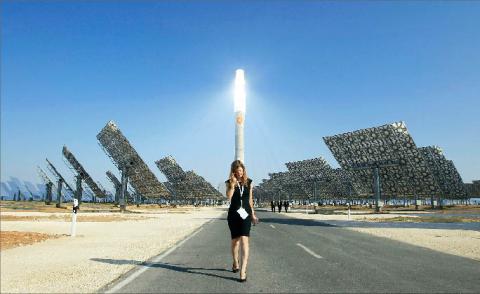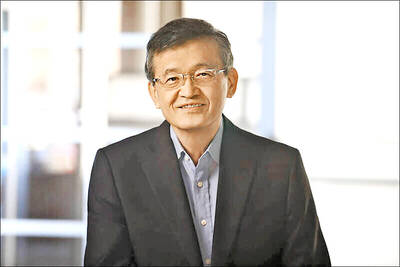Solar energy may finally get its day in the sun. The high costs that for years made it impractical as a mainstream source of energy are plummeting. Real-estate companies are racing to install solar panels on office buildings, utilities are erecting large solar panel “farms” near big cities and in desolate deserts and creative financing plans are making solar more realistic than ever for homes.
Solar power installations doubled in the US last year and are expected to double again this year. More solar energy is being planned than any other power source, including nuclear, coal, natural gas and wind.
“We are at the beginning of a turning point,” says Andrew Beebe, who runs global sales for Suntech Power Holdings Co (尚德), a manufacturer of solar panels.

Photo: Reuters
Solar’s share of the power business remains tiny, but its promise is great. The sun splashes more clean energy on the planet in one hour than humans use in a year, and daytime is when power is needed most. Moreover, solar panels can be installed near where people use power, reducing or eliminating the costs of moving power through a grid.
Solar power has been held back by costs. It’s still about three times more expensive than electricity produced by natural gas, according to estimates by the US Energy Information Administration.
However, the financial barriers are falling fast. Solar panel prices have plunged by two-thirds since 2008, making it easier for installers to market solar’s financial benefits and not simply its environmental ones. Homeowners who want to go solar can do so for free and pay the same or less for their power.
Last month, two of the nation’s biggest utilities, Exelon Corp and NextEra Energy Inc, each acquired a large California solar power farm in the early stages of development. Another utility, NRG Energy Inc, has announced a plan with Bank of America and the real estate firm Prologis Inc to spend US$1.4 billion to install solar systems on 750 commercial rooftops.
Nationwide, solar power installations grew by 102 percent from 2009 to last year, by far the fastest rate in the past five years.
Making solar affordable still requires large tax breaks and other subsidies from federal and state governments. The main federal subsidy pays for 30 percent of the cost of a residential system. When state and other subsidies are added, as much as 75 percent of the cost can be covered.
However, prices of solar panels, the squares of crystalline silicon or thin layers of metal films that turn the sun’s rays into electricity, are falling so fast that its advocates now credibly claim that solar will be able to compete with fossil fuels even when the federal solar subsidy shrinks by two-thirds in 2016.
The falling prices have made it easier for solar installers to raise the money needed to grow. And they’ve made solar power systems so affordable they can appeal to homeowners who want to save on their electric bill, not just reduce their environmental impact.
Some installers are teaming up with big hardware chains Home Depot and Lowe’s in an effort to expose solar to customers who might not otherwise consider it.
Solar panel prices have been declining for years because of lower costs for polycrystalline silicon, the main raw material for most solar panels, and larger-scale manufacturing, especially in Asia. In the last six months, demand has dropped sharply in Germany, the world’s biggest solar market, in response to shrinking subsidies. This has created a global glut of solar panels and accelerated the decline in prices.
Solar panels, which are priced based on the amount of power they can produce during full sunshine, sold for US$1.34 per watt in the middle of last month, according to data from Bloomberg New Energy Finance. That’s down from US$1.90 at the beginning of last year. In 2008, they sold for US$4 a watt.
The glut has been gut-wrenching for companies that make solar panels. Many of them remain profitable and are growing, but three US panel makers have filed for bankruptcy in two months, including Solyndra, a solar panel maker that received a US$528 million federal loan.
Falling profit margins are scaring investors. The stock price of First Solar Inc has fallen from US$170 in April to US$53.77. Suntech has fallen from US$11 to US$2.07 over the same period.
The Solyndra bankruptcy has sparked a political uproar. Republicans have accused US President Barack Obama’s administration of pushing for Solyndra’s loan for political reasons and have used the bankruptcy to question Obama’s plan to help boost the economy by subsidizing clean energy projects.
The market will not get any easier for small solar panel makers. General Electric Co, Samsung Electronics Co and other big companies are entering the market.
However, what has been treacherous for solar panel makers has been a boon for companies that market and install solar systems, for companies that make electronics and other parts for solar systems, and for solar customers.
To be sure, solar is growing from a very small base. All of the panels now installed across the nation produce enough electricity to power 600,000 homes, or about as much electricity as one large coal-fired power plant.
There are 30,000 megawatts worth of solar projects awaiting approval in the US, according to the American Public Power Association. Not all of them will be built, either because of regulatory or financial hurdles. However, even if only half that is ultimately built, it would be five times what is already installed.

Intel Corp chief executive officer Lip-Bu Tan (陳立武) is expected to meet with Taiwanese suppliers next month in conjunction with the opening of the Computex Taipei trade show, supply chain sources said on Monday. The visit, the first for Tan to Taiwan since assuming his new post last month, would be aimed at enhancing Intel’s ties with suppliers in Taiwan as he attempts to help turn around the struggling US chipmaker, the sources said. Tan is to hold a banquet to celebrate Intel’s 40-year presence in Taiwan before Computex opens on May 20 and invite dozens of Taiwanese suppliers to exchange views

Application-specific integrated circuit designer Faraday Technology Corp (智原) yesterday said that although revenue this quarter would decline 30 percent from last quarter, it retained its full-year forecast of revenue growth of 100 percent. The company attributed the quarterly drop to a slowdown in customers’ production of chips using Faraday’s advanced packaging technology. The company is still confident about its revenue growth this year, given its strong “design-win” — or the projects it won to help customers design their chips, Faraday president Steve Wang (王國雍) told an online earnings conference. “The design-win this year is better than we expected. We believe we will win

Chizuko Kimura has become the first female sushi chef in the world to win a Michelin star, fulfilling a promise she made to her dying husband to continue his legacy. The 54-year-old Japanese chef regained the Michelin star her late husband, Shunei Kimura, won three years ago for their Sushi Shunei restaurant in Paris. For Shunei Kimura, the star was a dream come true. However, the joy was short-lived. He died from cancer just three months later in June 2022. He was 65. The following year, the restaurant in the heart of Montmartre lost its star rating. Chizuko Kimura insisted that the new star is still down

While China’s leaders use their economic and political might to fight US President Donald Trump’s trade war “to the end,” its army of social media soldiers are embarking on a more humorous campaign online. Trump’s tariff blitz has seen Washington and Beijing impose eye-watering duties on imports from the other, fanning a standoff between the economic superpowers that has sparked global recession fears and sent markets into a tailspin. Trump says his policy is a response to years of being “ripped off” by other countries and aims to bring manufacturing to the US, forcing companies to employ US workers. However, China’s online warriors